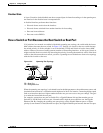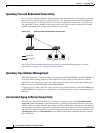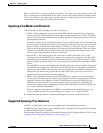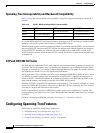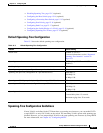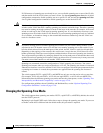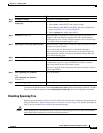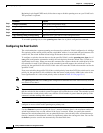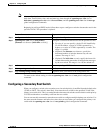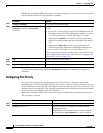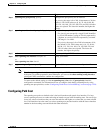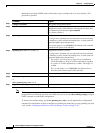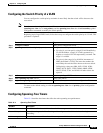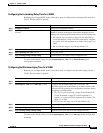
15-14
Catalyst 2960 Switch Software Configuration Guide
78-16881-01
Chapter 15 Configuring STP
Configuring Spanning-Tree Features
Beginning in privileged EXEC mode, follow these steps to disable spanning-tree on a per-VLAN basis.
This procedure is optional.
To re-enable spanning-tree, use the spanning-tree vlan vlan-id global configuration command.
Configuring the Root Switch
The switch maintains a separate spanning-tree instance for each active VLAN configured on it. A bridge
ID, consisting of the switch priority and the switch MAC address, is associated with each instance. For
each VLAN, the switch with the lowest bridge ID becomes the root switch for that VLAN.
To configure a switch to become the root for the specified VLAN, use the spanning-tree vlan vlan-id
root global configuration command to modify the switch priority from the default value (32768) to a
significantly lower value. When you enter this command, the software checks the switch priority of the
root switches for each VLAN. Because of the extended system ID support, the switch sets its own
priority for the specified VLAN to 24576 if this value will cause this switch to become the root for the
specified VLAN.
If any root switch for the specified VLAN has a switch priority lower than 24576, the switch sets its own
priority for the specified VLAN to 4096 less than the lowest switch priority. (4096 is the value of the
least-significant bit of a 4-bit switch priority value as shown in Table 15-1 on page 15-4.)
Note The spanning-tree vlan vlan-id root global configuration command fails if the value necessary to be the
root switch is less than 1.
Note If your network consists of switches that both do and do not support the extended system ID, it is unlikely
that the switch with the extended system ID support will become the root switch. The extended system
ID increases the switch priority value every time the VLAN number is greater than the priority of the
connected switches running older software.
Note The root switch for each spanning-tree instance should be a backbone or distribution switch. Do not
configure an access switch as the spanning-tree primary root.
Use the diameter keyword to specify the Layer 2 network diameter (that is, the maximum number of
switch hops between any two end stations in the Layer 2 network). When you specify the network
diameter, the switch automatically sets an optimal hello time, forward-delay time, and maximum-age
time for a network of that diameter, which can significantly reduce the convergence time. You can use
the hello keyword to override the automatically calculated hello time.
Command Purpose
Step 1
configure terminal Enter global configuration mode.
Step 2
no spanning-tree vlan vlan-id For vlan-id, the range is 1 to 4094.
Step 3
end Return to privileged EXEC mode.
Step 4
show spanning-tree vlan vlan-id Verify your entries.
Step 5
copy running-config startup-config (Optional) Save your entries in the configuration file.




